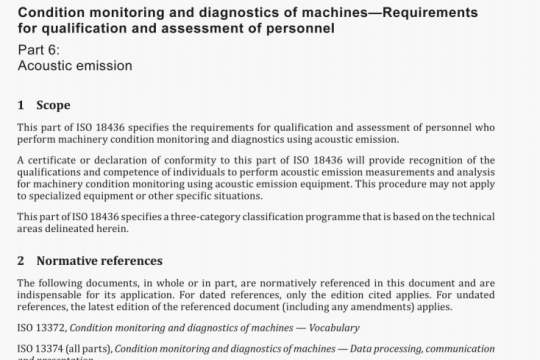ISO 23380:2013 pdf free
ISO 23380:2013 pdf free.Selection of methods for the determination of trace elements in coal
A summary of techniques applicable to the determination of each of the trace elements is discussed below. A schematic of procedures used for trace element determinations is given in Annex A.
It is critical that moisture be determined on the sample to enable calculation to bases other than “air-dried”.
NOTE 1 There are digestion procedures applicable to unashed coal. The application ofthese is discussed in AnnexB.
NOTE 2 Boron, chlorine, fluorine, mercury, and selenium are released if coal is ashed; thus, it is not possible to estimate the concentration of these elements in coal by analysing laboratory-prepared ash.
Where digestion procedures require ashing of the coal, it is critical to determine the ash yield to enable calculation of trace elements content in the coal sample (see Clause 7). Ashing procedures are described in ISO 152381[6]. Coals are ashed in silica or quartz dishes, or in platinum or platinum alloy crucibles/ basins, in a conventional ashing furnace. The furnace temperature is ramped from ambient to a maximum of 500 °C over 1 h to 3 h and held at this temperature until the carbonaceous material is completely oxidized or for a maximum of 18 h. The ramp rate is selected to avoid ignition and mechanical loss of sample.
Arsenic and selenium are determined by hydride generation/ atomic absorption or atomic fluorescence techniques following the ashing of the coal at 800 °C in the presence of Eschka mixture and dissolution with hydrochloric acid. Iso 11723[3] is the recommended method for the determination of arsenic and selenium in coal.
Arsenic can be determined in coal by the analysis of ash prepared in a laboratory at a temperature no greater than 500 °C. Selenium is vaporized at quite low temperatures and is not recovered in ash. There is no International Standard for the determination of arsenic in coal ash. A suitable procedure is the dissolution of the ash either by fusion or by mixed acids (nitric, hydrochloric, and hydrofluoric acids) and determination of the analyte by hydride/AAS or hydride/AFS. This element can also be determined by ICP-MS if the interference caused by argon chloride is eliminated.ISO 23380 pdf download.




